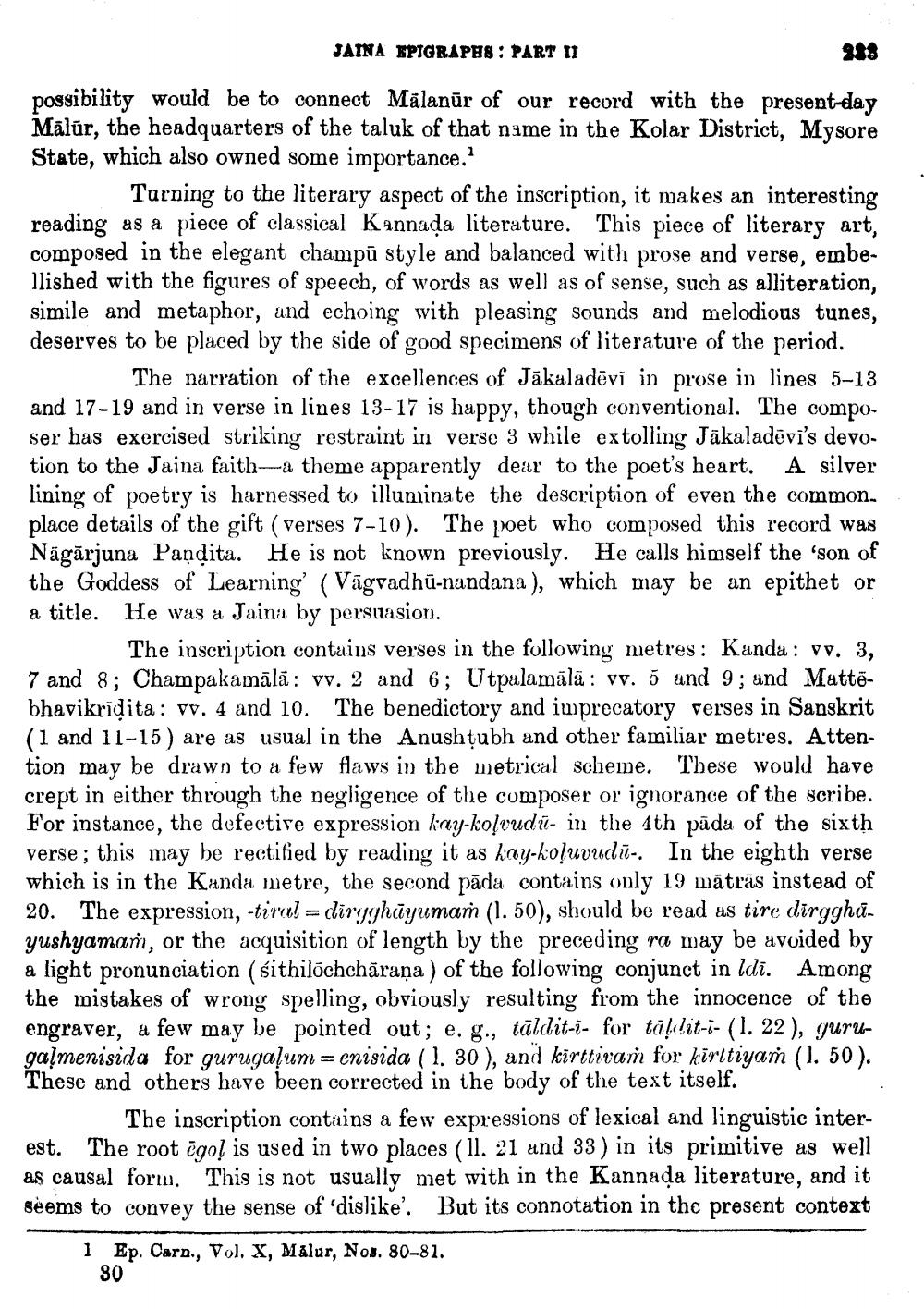________________
JAINA EPIGRAPHS: PART II
possibility would be to connect Mälanur of our record with the present-day Malur, the headquarters of the taluk of that name in the Kolar District, Mysore State, which also owned some importance.1
Turning to the literary aspect of the inscription, it makes an interesting reading as a piece of classical Kannada literature. This piece of literary art, composed in the elegant champū style and balanced with prose and verse, embellished with the figures of speech, of words as well as of sense, such as alliteration, simile and metaphor, and echoing with pleasing sounds and melodious tunes, deserves to be placed by the side of good specimens of literature of the period.
288
The narration of the excellences of Jakaladevi in prose in lines 5-13 and 17-19 and in verse in lines 13-17 is happy, though conventional. The composer has exercised striking restraint in verse 3 while extolling Jakaladevi's devotion to the Jaina faith-a theme apparently dear to the poet's heart. A silver lining of poetry is harnessed to illuminate the description of even the common. place details of the gift (verses 7-10). The poet who composed this record was Nagarjuna Pandita. He is not known previously. He calls himself the 'son of the Goddess of Learning' (Vägvadhu-nandana), which may be an epithet or a title. He was a Jaina by persuasion.
The inscription contains verses in the following metres: Kanda: vv. 3, 7 and 8; Champakamālā: vv. 2 and 6; Utpalamälä: vv. 5 and 9; and Mattebhavikrīḍita: vv. 4 and 10. The benedictory and imprecatory verses in Sanskrit (1 and 11-15) are as usual in the Anushṭubh and other familiar metres. Attention may be drawn to a few flaws in the metrical scheme. These would have crept in either through the negligence of the composer or ignorance of the scribe. For instance, the defective expression kay-koļvudu- in the 4th pada of the sixth verse; this may be rectified by reading it as kay-koļuvudu-. In the eighth verse which is in the Kanda metre, the second pada contains only 19 mātrās instead of 20. The expression, -tiral dirgghāyumaṁ (1. 50), should be read as tire dirgghayushyamam, or the acquisition of length by the preceding ra may be avoided by a light pronunciation (śithilōchchāraṇa) of the following conjunct in ldi. Among the mistakes of wrong spelling, obviously resulting from the innocence of the engraver, a few may be pointed out; e. g., tāldit-i- for taldit-i- (1. 22), gurugalmenisida for gurugalumenisida (1. 30), and kirttivam for kirttiyam (1. 50). These and others have been corrected in the body of the text itself.
The inscription contains a few expressions of lexical and linguistic interest. The root égol is used in two places (11. 21 and 33) in its primitive as well as causal form. This is not usually met with in the Kannada literature, and it seems to convey the sense of 'dislike'. But its connotation in the present context
1
Ep. Carn., Vol. X, Malur, Nos. 80-81.
80




